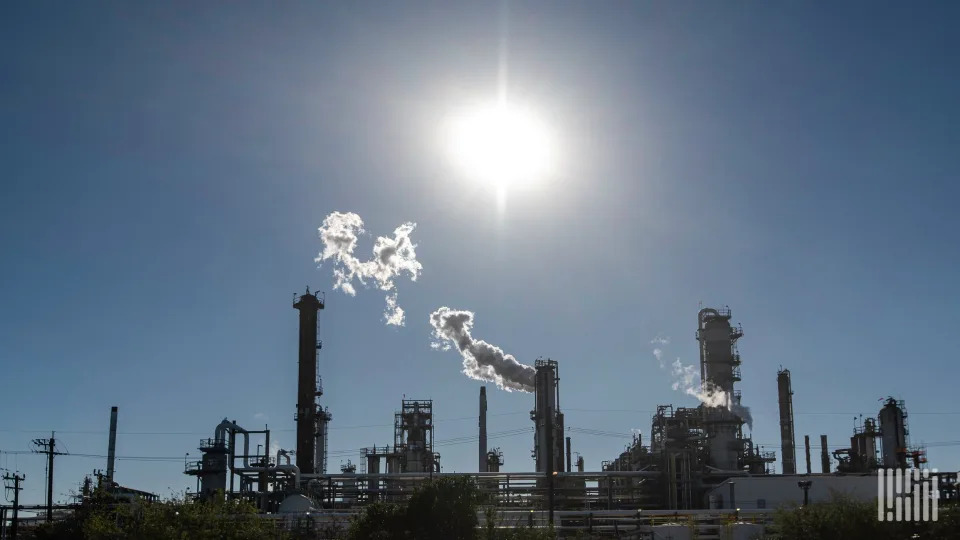
Energy markets on Monday at least partly shrugged off the potential impact on prices of new U.S. tariffs.
Most of the tariffs are set to take effect on Tuesday, though Trump extended the deadline for Mexico by one month after its president pledged to deploy 10,000 National Guard troops to the U.S.-Mexico border.
Refiners balk at higher costs
In the immediate aftermath of the announcement, West Texas Intermediate (WTI) — a domestic benchmark — crude futures surged by $2.65 per barrel, outpacing the $1.67 increase in Brent crude. WTI prices have since come down after the one-month delay for Mexico was reported.
Still, a narrowing spread between WTI and Brent is emblematic of the market’s perception of heightened supply risks within the United States.
The tariffs pose a significant challenge for U.S. refiners, which are already grappling with declining profit margins. Amrita Sen, director of research at Energy Aspects, told Bloomberg, “It’s a win for a lot of the rest of the world, just a massive loss for U.S. refining.” The 10% levy on Canadian oil imports, while lower than the blanket 25% rate, is expected to add to the costs of refiners in the Midwest and on the West Coast.
However, a weakened Canadian dollar may absorb some of this impact .
A pressing concern for U.S. refiners lies in the now-delayed 25% tariff on Mexico. Refineries along the Gulf Coast face substantially higher costs for the approximately 400,000 barrels per day (bpd) of Mexican crude — and an additional 200,000 bpd of fuel oil imports — they process. This situation could potentially benefit Asian refiners at the expense of their U.S. counterparts.
Industry leaders have expressed apprehension about the tariffs’ impact on consumer prices and energy affordability.
Chet Thompson, president and CEO of American Fuel & Petrochemical Manufacturers, stated, “We are hopeful a resolution can be quickly reached with our North American neighbors so that crude oil, refined products and petrochemicals are removed from the tariff schedule before consumers feel the impact.”
The tariffs are likely to restructure the North American oil trade. Canada, leveraging its expanded Trans Mountain pipeline, could redirect more oil exports to Asia from its Pacific Coast. This diversion could force U.S. refiners to seek alternatives at potentially higher costs. Mexico, in turn, might retaliate by limiting oil supplies to the United States, exacerbating supply pressures.
Energy costs unlikely to fuel inflation
Goldman Sachs analysts predict that oil and gas prices are unlikely to see a runaway rally from these tariffs, though some refiners have already begun to raise prices in anticipation of higher costs.
“Potential tariff-driven decline in U.S. natural gas imports from Canada is too small to significantly raise U.S. natural gas prices,” the bank said in a note released Sunday. “Canadian oil producers are expected to eventually bear most of the burden of the tariff […], with U.S. consumers of refined products bearing the remaining $2 to $3 a barrel burden.”
The tariffs’ impact on U.S. domestic production remains uncertain. While the measures could theoretically incentivize increased domestic output, many U.S. oil and gas companies have expressed reluctance to boost production without a significant increase in oil prices. The industry’s response will likely be tempered by concerns over creating a supply glut that could drive prices down further.
Potential benefits of the tariff strategy include the possibility of increased long-term deals for U.S. gas exports, as foreign buyers seek to secure supply agreements ahead of potential further trade restrictions.
Ben Dell, managing partner at energy investment firm Kimmeridge, noted, “People want to be early and in the forefront of signing up for U.S. products to try and stave off potential tariff threats.”
However, the risks associated with this approach are substantial.
Higher fuel prices could lead to reduced consumption, weighing on U.S. economic growth. The tariffs also raise the specter of retaliatory measures from Canada and Mexico with far-reaching consequences for the North American energy market.
Moreover, the tariffs threaten to disrupt long-established supply chains and refining operations optimized for specific crude grades. U.S. refineries, particularly those in the Midwest, have invested heavily in technologies designed to process heavier Canadian crude. Shifting to alternative sources could prove costly and inefficient in the short term, especially given the ever-changing status of trade negotiations.
As the situation continues to evolve, staying informed will be critical for navigating the complex interplay of trade policy, market dynamics and industry strategy in the energy sector.
For the latest updates on how these tariffs are reshaping the energy landscape and their implications for industry stakeholders, readers are encouraged to subscribe to FreightWaves’ industry newsletters and market forecasts .
The post Energy markets panic over tariffs, but then relax appeared first on FreightWaves .
